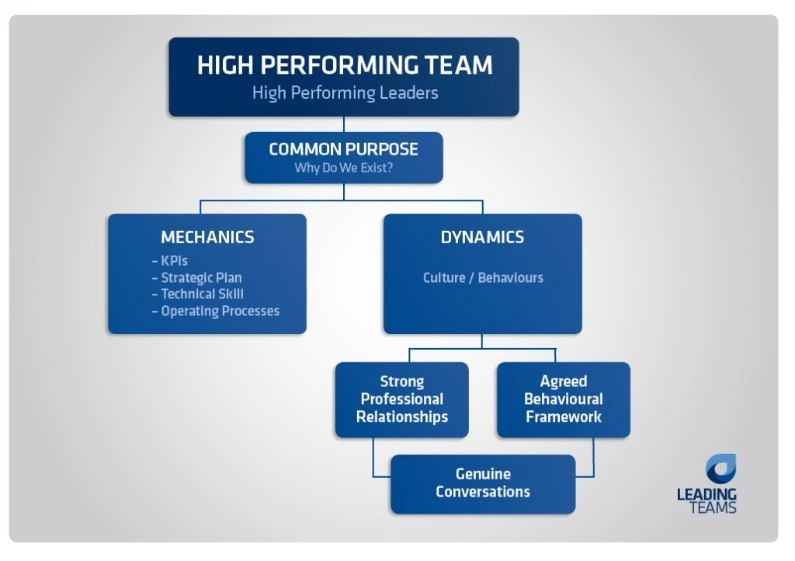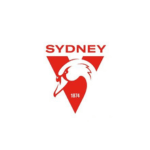What is a High-Performing Team?
A high performing team is one that exceeds all reasonable expectations and produces extraordinary results.
Whether it’s a sporting team, debating club, band, family trip or office project, we’ve all experienced what it’s like to be part of a team that has felt high performing.
And, no doubt, we’ve all had the experience of being a part of team that is clearly not high performing.
The challenge for most of us, is that it can be difficult to identify what it would take to change a team that’s not performing, into one that is.
At Leading Teams, we specialise in partnering with teams to help them identify what changes need to be made in order to be high-performing. We do this by helping them to apply a methodology backed by over 30 years of evidence and hands on experience.
We call this methodology, the High Performing Teams Model.
Simply put, we believe that high performing teams are those that:
- Are led by high performing leaders
- Connect to their why
- Balance their investment in their what and how
by narrowing the gap between what they say they do, and what they actually do.

Characteristics of a high-performing team
High Performing Leaders
A team can only be high performing if its’ leaders are also high performing. Notably, we don’t believe that hierarchical leadership or management positions are necessarily a function of leadership, rather we focus on leadership as a function of influence. Within any team, there are those who wield influence over others.
Sometimes they do this because of the position, authority or experience they hold. A powerful example of leaders driving culture is a story about a car dealership Leading Teams worked with in Brisbane. Every Monday morning the leaders were seen out the front of the dealership picking up the rubbish left by partygoers in the car parking lot over the weekend. As leaders they didn’t have to do this, they could have easily delegated this task. However, doing so sent a clear message to all team members,
especially new ones about the culture of their team and how to behave.
A common purpose – Your ‘Why’
It’s difficult to work at your best if you’re unsure of what you’re working towards. Organisations that are high performing are clear on their purpose and what that means to teams within the organisation. When you can set clear objectives for your business and communicate what role each of your teams and employees plays in this process you set up a pathway to success.
Mechanics
This encompasses what the team does. It is things like be technical skills and operating processes measured by results, KPIs and strategic plans. This is also where ‘talent’ sits. To be high performing, you need to perform you mechanics well. But, it’s not the only thing that is important in teams. The other important part is the Dynamics – how the team goes about it. Our facilitators focus on team dynamics that allows teams to be better at their mechanics.
Investing time into the dynamics of a team can have a measurable impact on a teams success, whatever the measure. Think about your team meetings. How much time do you spend talking about mechanics versus discussing how you do things?
Agreed behavioural framework- Your ‘How’
If you’re not actively shaping the behaviours of your team members, you’re actively neglecting a key component of any high performing team. Behaviours drive everything we do, both good and bad. Behavioural frameworks are essentially agreements you create as a team around the behaviours you will or won’t accept. In high performance organisations, these desired behaviours drive all business interactions.
Why does your team accept those behaviours? Which behaviours are rewarded? Who are you rewarding in your team? Not just through promotion and career progression, but whose projects get attention, how much time do you spend with each team member?
If the people getting rewarded are exhibiting poor behaviours, what does that tell the other team members?
Once your team has a healthy culture, where team members feel valued and are exhibiting productive behaviours, imagine how they will improve the processes and systems that allow your team to go about its work. An agreed behavioural framework is the start of creating an empowered team where everyone knows how to behave and has a sense of connection and ownership over
the team and how it performs.
Strong Professional Relationships
Building strong relationships in a team is an investment. An investment of time, and of attention. It means genuinely getting to know someone not just for the role they play in your team but for who they are as a whole person.
A great way to build connections and relationships is through regular team checkins that focus not just on the mechanics of the team but the people and their dynamics.
Giving each team member time to share how they are going, both personally and professionally, can provide insights into current performance and circumstances.
An environment of mutual trust and respect must exist for these check-ins to go below surface level and often it is up to the leader of the group to be vulnerable and open to allow the rest of the team to feel safe to do the same.
Genuine Conversations (Feedback)
Quite simply, a genuine conversation is a conversation about performance, with the intent of helping someone in your team to improve, whatever their role or level of responsibility in the business. We don’t label feedback as positive or negative – if it comes from the right place, all feedback is an opportunity to improve.
Feedback is something we work regularly with teams on. Often we are asked what the best way to give feedback is – well, it depends. The best way will be what is best for your team mates. The level of genuineness in a genuine conversation is directly linked to the strength of relationship you have with the person.
When you have an environment of trust and respect, and an agreement on the way you do things, then you can have a genuine conversation. It’s rewarding someone when you see them living your behaviours, and challenging them when you don’t see it.
What the reward and challenge look like for your team is as unique as the purpose of a team. We help you find out what that looks like in your team.
How to build a high performing team?
Now you know the key characteristics of a High Performing Team, how do you start to build that in your team?
Start allocating time to culture
The first step is to acknowledge the role team culture has in driving performance. Often leaders spend the majority of their time focused on KPIs, strategic plans and outcomes. A shift in focus to culture can unlock the potential and discretionary effort
within teams.
Leaders need to model, reward and challenge
A leader’s role is to set the standards in all aspects of high performing teams. Much like building strong relationships the leader needs to lead the way in seeking and actioning feedback about their own performance. That doesn’t mean every piece of feedback needs to be actioned immediately, it does mean that team members feel empowered to give the leader/s feedback without fear of retribution.
This also means leaders can reward and challenge team members to help improve their performance. Having an agreed behavioural framework is crucial to ensuring a team has a shared language to use when providing feedback to colleagues.
A 2023 Gallup report found that employees that strongly agree that recognition/reward are an important part of their organsiations culture are 3.8x as likely to agree that they are strongly connected to their culture.
Empowering your team
A team cannot be told they are empowered – they must feel it and believe it. That means it is a hard thing to build, but if leaders invest enough time into building relationships, clarifying purpose, and creating an agreed behavioural framework it will put their team in the best position to feel empowered.
High Performing Teams Results
Read about real teams that Leading Teams has partnered with, these teams have invested time and energy into their culture and have reaped the rewards.
Next steps
Do you want help creating your high performing team? Head to our Performance Improvement Program page to get started.
Read Ray McLean’s books on how the Leading Teams High Performance Model was created and how it has been utilised by teams across Australia teams and organisations.
How we help
We facilitate face-to-face conversations using a framework to support cultural change, teamwork and leadership.






